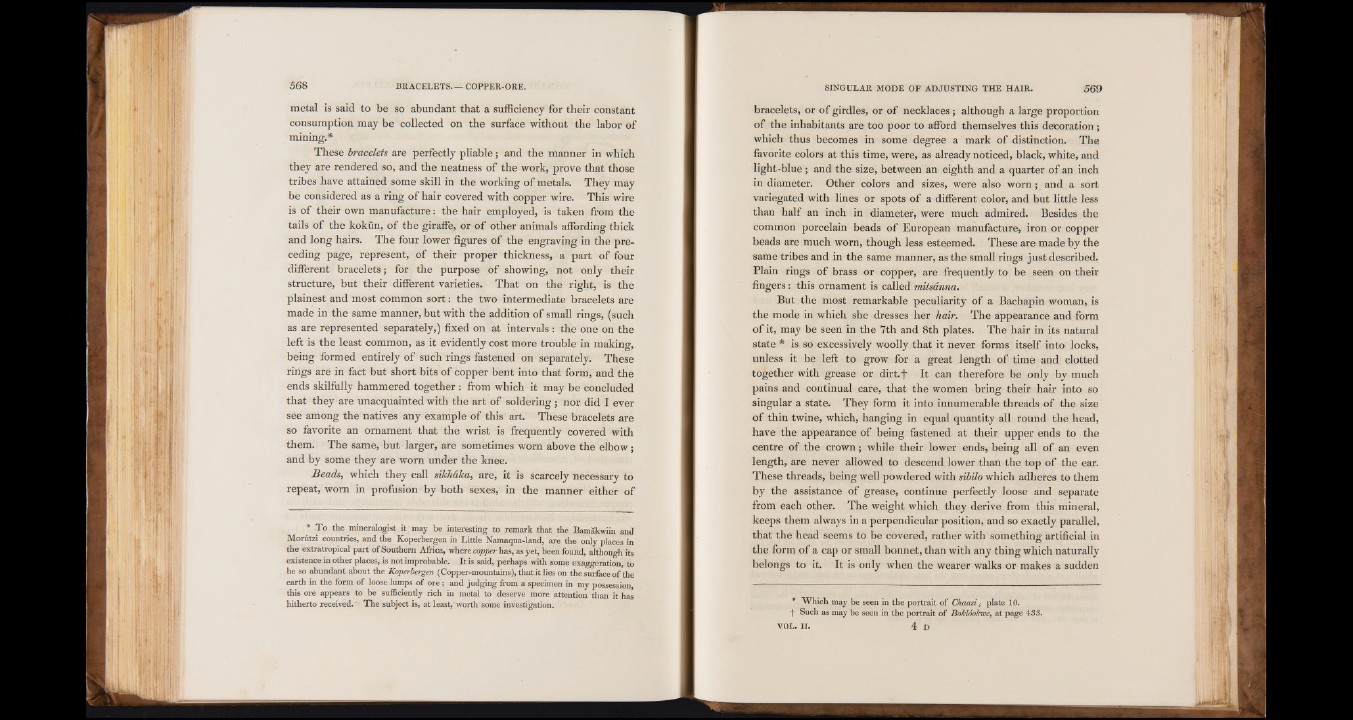
metal is said to be so abundant that a sufficiency for their constant
consumption may be collected on the surface without the labor of
mining.*
These bracelets are perfectly pliable; and the manner in which
they are rendered so, and the neatness of the work, prove that those
tribes have attained some skill in the working of metals. They may
be considered as a ring of hair covered with copper wire. This wire
is of their own manufacture: the hair employed, is taken from the
tails of the kokün, of the giraffe, or of other animals affording thick
and long hairs. The four lower figures of the engraving in the preceding
page, represent, of their proper thickness, a part of four
different bracelets; for the purpose of showing, not only their
structure, but their different varieties. That on the right, is the
plainest and most common sort: the two intermediate bracelets are
made in the same manner, but with the addition of small rings, (such
as are represented separately,) fixed on at intervals: the one on the
left is the least common, as it evidently cost more trouble in making,
being formed entirely of such rings fastened on separately. These
rings aré in fact but short bits of copper bent into that form, and the
ends skilfully hammered together: from which it may be concluded
that they are unacquainted with the art of soldering ; nor did I ever
see among the natives any example of this art. These bracelets are
so favorite an ornament that the wrist is frequently covered with
them. The same, but larger, are sometimes worn above the elbow;
and by some they are worn under the knee.
Beads, which they call sikháka, are, it is scarcely necessary to
repeat, worn in profusion by both sexes, in the manner either of
* To the mineralogist it may be interesting to remark that the Bamakwiin and
Morútzi countries, and the Koperbergen in Little Namaqun-Iand, are the only places in
the extratropical part of Southern Africa, where copper has, as yet, been found, although its
existence in other places, is not improbable. It is said, perhaps with some exaggeration, to
be so abundant about the Kqperbergen (Copper-mountains), that it lies on the surface of the
earth in the form of loose lumps of ore; and judging from a specimen in my possession
this ore appears to be sufficiently rich in metal to deserve more attention than it has
hitherto received. The'subject is, at least, worth' some investigation.
bracelets, or of girdles, or of necklaces; although a large proportion
of the inhabitants are too poor to afford themselves this decoration;
which thus becomes in some degree a mark of distinction. The
favorite colors at this time, were, as already noticed, black, white, and
light-blue; and the size, between an eighth and a quarter of an inch
in diameter. Other colors and sizes, were also worn; and a sort
variegated with lines or spots of a different color, and but little less
than half an inch in diameter, were much admired. Besides the
common porcelain beads of European manufacture, iron or copper
beads are much worn, though less esteemed. These are made by the
same tribes and in the same manner, as the small rings just described.
Plain rings of brass or copper, are frequently to be seen on their
fingers: this ornament is called mitsdnna.
But the most remarkable peculiarity of a Bachapin woman, is
the mode in which she dresses her hair. The appearance and form
of it, may be seen in the 7th and 8th plates. The hair in its natural
state * is so excessively woolly that it never forms itself into locks,
unless it be left to grow for a great length of time and clotted
together with grease or dirt, j- It can therefore be only by much
pains and continual care, that the women bring their hair into so
singular a state. They form it into innumerable threads of the size
of thin twine, which, hanging in equal quantity all round the head,
have the appearance of being fastened at their upper ends to the
centre of the crown; while their lower ends, being all of an even
length, are never allowed to descend lower than the top of the ear.
These threads, being well powdered with sibilo which adheres to them
by the assistance of grease, continue perfectly loose and separate
from each other. The weight which they derive from this mineral,
keeps them always in a perpendicular position, and so exactly parallel,
that the head seems to be covered, rather with something artificial in
the form of a cap or small bonnet, than with any thing which naturally
belongs to it. It is only when the wearer walks or makes a sudden
* Which may be seen in the portrait of Chaasi ¡ plate 10.
j- Such as may be seen in the portrait of Boklóoleux, at page 433.
VOL. II. 4 D